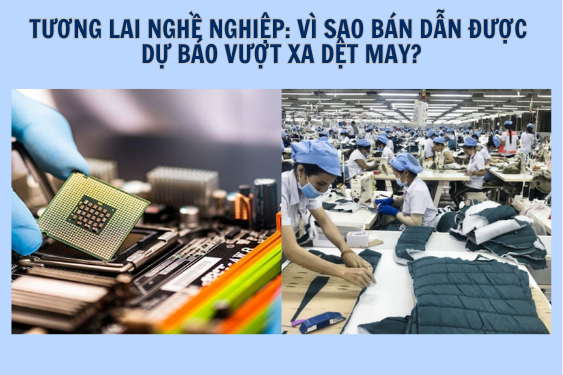1. The Context of the Semiconductor and Electronics Components Industry in Vietnam
The semiconductor and electronics components industry is emerging as a key sector in Vietnam's economy, fueled by a sharp rise in foreign direct investment (FDI). Major technology corporations such as Intel, Samsung, Amkor, Foxconn, Wistron, and Pegatron are actively building and expanding their manufacturing facilities across the country. This surge has created an urgent demand for both general labor and highly skilled professionals. However, the current workforce falls short in terms of both quantity and quality needed to meet the industry’s growing requirements.
According to forecasts, over the next 2–3 years, as semiconductor and electronics manufacturers shift up to 60% of their production capacity to Vietnam, the industry will require over 50,000 additional engineers and specialists. This presents a critical challenge, especially as major companies are currently concentrated in key industrial zones such as Bac Ninh, Bac Giang, Ha Nam, and Hai Phong. Without early preparation, the risk of a labor supply disruption is high. Workforce development is still hindered by barriers such as limited time, high costs, and inadequate infrastructure. As a result, Vietnam urgently needs breakthrough solutions in human resources—an essential factor to sustain its growth momentum and global competitiveness in the high-tech manufacturing sector.
2. GLA HR – Focused on Talent Solutions for the Semiconductor and Electronics Components Industry
GLA HR is a pioneer in providing and training high-skilled talent, with a strategic focus on the semiconductor and electronics components industry. Having partnered with major corporations such as Foxconn, Wistron, Pegatron, Amphenol, and Hon Yao Fu, GLA HR has gained in-depth experience and a strong understanding of the industry's unique characteristics. This allows the company to clearly identify workforce demands and deliver tailored HR solutions that effectively meet the needs of its clients.
Beyond talent placement, GLA HR invests heavily in comprehensive training programs—ranging from language and cross-cultural communication to essential technical skills—with the goal of building a high-quality workforce. This proactive approach ensures that Vietnamese talent is well-prepared to meet the rapidly growing demands of both international and regional companies.
3. Workforce Training with XR Technology – A Breakthrough Solution for Cost Optimization
One of the biggest challenges in semiconductor workforce training lies in the strict requirements for practical environments—especially cleanrooms, which are expensive to operate and maintain. To address this, GLA HR has pioneered the use of Extended Reality (XR) technology in its training programs. This allows trainees to interact with virtual production lines and machinery, simulating real-world scenarios without incurring the high costs of physical infrastructure.
XR technology offers highly realistic simulations of production processes, enabling trainees to practice and respond to real-world scenarios right from the training phase. Through this program, learners gain hands-on experience with the full 48-step semiconductor manufacturing process—replicated in a virtual cleanroom environment.
his approach not only reduces training costs but also shortens learning time, ensuring that trainees are job-ready immediately upon completion—eliminating the need for extended probation or on-the-job adjustment periods.
4. Language Training – A Critical Factor in the High-Tech Industry
In addition to technical expertise, language proficiency is a critical success factor in the semiconductor and electronics components industry. Most FDI enterprises operating in Vietnam originate from Taiwan, South Korea, China, the United States, and Europe. As a result, engineers are expected not only to be technically competent but also to possess strong communication skills and the ability to adapt to an international work environment.
Vietnam’s talent market is often described as having “no shortage of capable people, but lacking in language proficiency and practical skills.” This issue largely stems from the limitations in current training programs and a prevailing cultural mindset of being “afraid to make mistakes,” which significantly hampers learners’ confidence and real-world adaptability.
Recognizing this reality, GLA HR has developed specialized factory-focused language training programs tailored for the semiconductor and electronics workforce. These programs prioritize English and Chinese—the two most commonly used languages among Vietnam’s FDI partners. By combining theory with practical application, the training enables learners to quickly master industry-specific terminology and confidently communicate in multinational corporate environments.
4.1 Attracting Young Talent to STEM – Collaborating with Universities
One of GLA HR’s key strategies for building a sustainable talent pipeline is to attract students to pursue studies in Science, Technology, Engineering, and Mathematics (STEM). By partnering with leading universities, GLA HR is actively developing early-stage training programs that introduce students to the semiconductor industry while they are still in school—laying the groundwork for future-ready professionals.
Through internship programs, career orientation, and co-training initiatives with businesses, students gain hands-on experience from industry experts and enjoy better access to employment opportunities after graduation. Leveraging its strong partnerships with universities in major semiconductor and electronics manufacturing countries such as Taiwan, GLA HR also facilitates international internship opportunities to help students enhance their skills in real-world global settings. This is a vital step toward addressing long-term talent shortages and ensuring the sustainable development of Vietnam’s semiconductor and electronics components industry.
4.2 Talent Matching – Meeting Both Technical and Language Requirements
In addition to training the next generation of engineers, GLA HR plays a key role in connecting existing industry talent with FDI enterprises. We maintain a high-quality talent database of professionals who meet both technical and language proficiency requirements, enabling them to access high-paying job opportunities in professional environments alongside international experts.
The experienced engineers selected by GLA HR are not only highly capable professionals but also pioneers ready to mentor and guide the next generation. This approach fosters a sustainable talent ecosystem, ensuring that FDI enterprises in Vietnam have continuous access to a high-quality workforce to support long-term growth.
4.3 Positioning GLA HR as the Leading Talent Provider for the Semiconductor and Electronics Components Industry
With a comprehensive strategy spanning recruitment, training, and talent retention, GLA HR is poised to become the leading provider of human resources in Vietnam’s semiconductor and electronics components industry. We are committed to delivering the most effective workforce solutions to meet the demands of high-tech enterprises, especially in today’s highly competitive global landscape.


